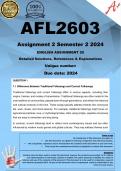AFL2603
Assignment 2 Semester 2 2024
ENGLISH ASSIGNMENT 20
Detailed Solutions, References & Explanations
Unique number:
Due date: 2024
QUESTION 1
1.1 Difference Between Traditional Folksongs and Current Folksongs
Traditional folksongs and current folksongs differ in various aspects, including their
origins, themes, and modes of transmission. Traditional folksongs are often rooted in the
oral traditions of communities, passed down through generations, and reflect the historical
and cultural contexts of the time. These songs typically address themes like communal
life, work, rituals, and moral lessons. For example, traditional folksongs might focus on
agricultural practices, love, or mythological tales, often using simple, repetitive structures
that are easy to remember and sing along.
In contrast, current folksongs tend to reflect more contemporary issues and are often
influenced by modern music genres and global cultures. They may address themes such
as social justice, identity, or personal experiences in a more individualistic context.
Terms of use
Current folksongs are frequently recorded, produced, and disseminated through digital
By making use of this document you agree to:
platforms, which means they
• can reach
Use this a broader
document audience
as a guide beyond
for learning, the local
comparison andcommunity.
reference purpose,
Moreover, •theNot to duplicate,
influence of reproduce and/or
technology misrepresent
allows the folksongs
current contents of this
to document as your
incorporate own work,
more
• Fully accept the consequences should you plagiarise or misuse this document.
complex arrangements, diverse instruments, and production techniques, setting them
apart from the simpler acoustic styles of traditional folksongs. Disclaimer
Extreme care has been used to create this document, however the contents are provided “as is” without
any representations or warranties, express or implied. The author assumes no liability as a result of
reliance and use of the contents of this document. This document is to be used for comparison, research
and reference purposes ONLY. No part of this document may be reproduced, resold or transmitted in any
form or by any means.




